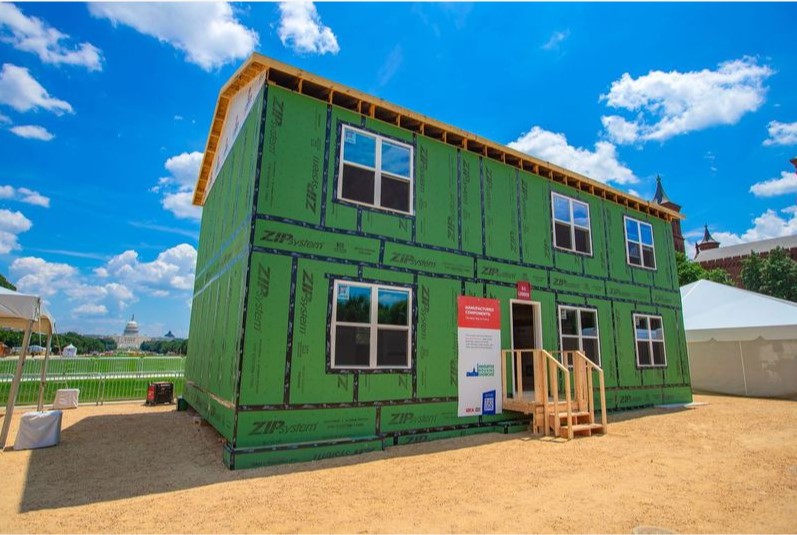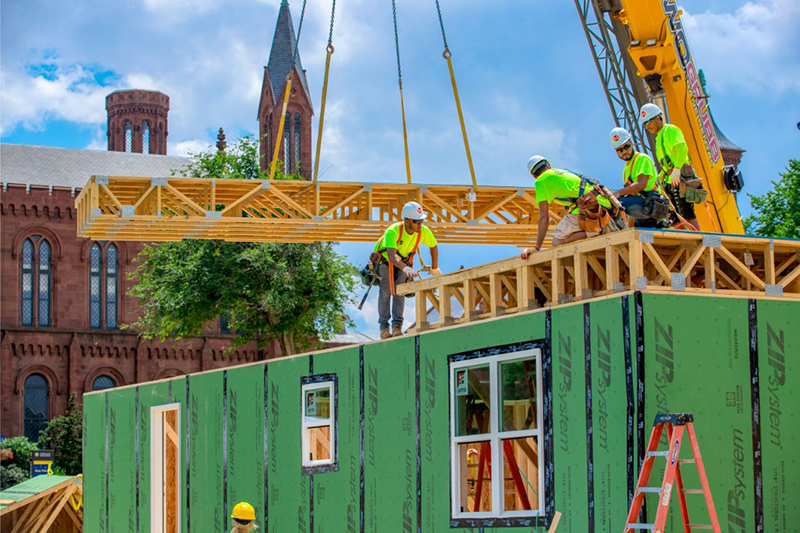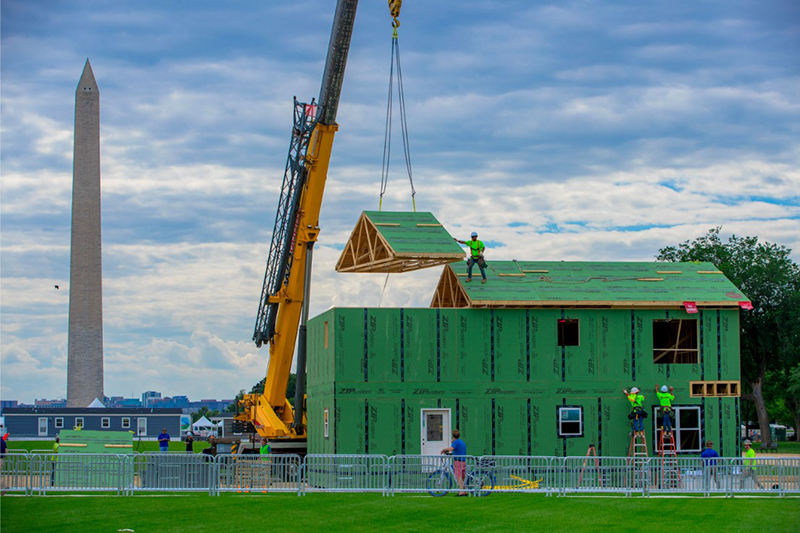The Innovations of SBCA’s IHS Build on the Mall
Originally Published by: SBCA Magazine — June 7, 2024
SBCA appreciates your input; please email us if you have any comments or corrections to this article.
This year, SBCA and NFC, in partnership with 84 Lumber, built a two-story home on the National Mall for HUD’s Innovative Housing Showcase in under eight (8) hours! That is no small feat. In order to make this possible, structural building components were utilized: roof truss panels, wall panels, and floor trusses, thus significantly cutting down on the overall construction cycle time, onsite time, labor needed, material wasted, and cost of the build. When working with offsite, there are many small innovations, solutions, and strategies throughout the entire process that lead to a big impact.
“Like most things in construction, there are several incremental innovations that yield large results, highlighting the nuances of doing little things a little better and more efficiently,” says Jess Lohse, SBCA’s Executive Director. “These incremental innovations produce a cumulative effect of enhancements to drive affordability and availability within the housing market.“
“84 Lumber was thrilled at the chance to collaborate with the SBCA at this year’s Innovative Housing Showcase,” says Ken Kucera, VP of Installed Sales and Manufacturing at 84 Lumber. “We really hope that this helps with efforts to promote the importance of sustainable, cost-effective housing solutions for communities across the U.S. Our team was able to accomplish the feat of building a structure in less than eight hours because we were able to pre-build the floor trusses, roofing truss panels, and the wall panels. We were able to do this by working together with our framers and manufacturers at our Winchester component plant. We hope this creates a new pathway when it comes to new builds.”
There are multiple interesting innovations implemented in SBCA’s Innovative Housing Showcase exhibit this year:
Insul-Stud by Moment Innovations, LLC — With various states adopting the most recent version of the energy code, this product provides an innovative solution with minimal impact to traditional framing methods. These studs eliminate thermal bridging (where cold air or warm air transmits through the building envelope) and as a result are 40% more energy efficient than a solid 2x6 stud. All of this is accomplished within the wall cavity allowing builders to meet the energy code requirements without having to add foam or make the wall wider, thus allowing for conventional installation of wall sheathing, siding, and window/door jambs.
“We are grateful to have our Insul-Stud by Moment Innovations, LLC, as part of SBCA’s Innovative Housing Showcase build this year. This showcase is about finding innovative solutions to the housing crises in our nation, and this is just one of them,” says Gene Frogale, President of Blue Ocean Development & Founding Partner of Moment Innovations. “It is exciting to be part of the efforts at work to make a difference in our industry. We are glad to part of it.”
EcoSmart™ Stud—The EcoSmart™ Construction Stud is a 1-to-1 replacement for a standard construction stud. The E-Stud has gaps which reduce thermal bridging by allowing insulation to fill in the gaps. They can build a highly efficient, low complexity, low carbon, resilient, composite wall system at a low cost for all homes. Panelized construction starts with basic wall panels like those used in the house on the National Mall. The EcoSmart™ Stud can be used in basic panelized walls to modular construction and every version in-between.
“It was seamless to integrate the EcoSmart Stud into the wall panels for the home at an 84 Lumber facility in Virginia and then shipped to the National Mall,” says Jon Pues, the product’s inventor. “The entire home was assembled in just one day! That is one of the advantages of panelized construction. Getting a house assembled and dried in as quickly as possible has always been a big deal in the construction of new homes or major remodels.”
Panel Straps – This is a tool that helps speed up the process. Initially, framers used to take rolls of seat belt material, cut them to length, make a loop out of it, and then staple or nail it into the panel to use for moving the panels. Now, we have a specific strap for this exact need, thus making it more efficient and easier to use. While it may potentially only save 5 seconds, those five seconds add up. If you have 100 panels, at 5 seconds per panel, that’s saving 500 seconds (over 8 minutes) – that adds up over time.
“Components bring an ease to not only the overall construction build and cycle time, but also to the downstream trades,” continues Jess. “With components, like trusses, they’re not having to cut, drill, or ruin the structure in order to add in the HVAC, plumbing, electrical, or other additions onsite. Thus, producing a more efficient, and affordable, home building process.”
Oak Ridge National Laboratory’s Real Time Evaluator (RTE) – This year, SBCA worked with the U.S. Department of Energy’s Oak Ridge National Laboratory to utilize their prototype Real-Time Evaluator (RTE) while installing wall panels into the house on the Mall for HUD’s Innovative Housing Showcase. This is a great opportunity to showcase how new technologies can make the installation of prefabricated components more efficient, making housing more affordable. The RTE was developed to provide real-time feedback to installers of prefabricated components, such as trusses and wall panels. With the RTE, a digital twin, or model, is developed based on the drawings of the house design. At the jobsite, an autonomous robotic tracker follows targets that are placed on the components and provides the actual position of the component.
The RTE compares the actual position to the designed location in the digital twin and provides real-time feedback on where the component needs to go to meet the required tolerances. If the final location of the component does not match the digital twin, upcoming software for the RTE will use the as-built information to adjust the digital twin so that errors do not accumulate throughout the assembly process. The RTE real-time feedback will be available on any digital device, making its information accessible to the installation crew and the design team.
“The idea of the Real Time Evaluator (RTE) came to fruition after I attended a presentation on prefabricated construction in which the speaker noted that tolerances were verified with a 3D scanner after assembly was completed”, states Dr. Diana Hun, Group Leader of the Building Envelope Materials Research at Oak Ridge National Laboratory. “We should modernize our construction practices and move from a reactive to a proactive approach. That is, instead of following the typical build-and-fix approach, we should transform the industry with real-time feedback that enables us to meet requirements faster and cheaper.”
“Having the opportunity to work with SBCA on their Innovative Housing Showcase build and using the RTE during the installation of some of the components of the house was a fantastic collaboration,” Dr. Hun continues. “It allows us to feature this new technology, show its value, and gather feedback so that it can meet industry needs. We are excited to contribute to housing affordability by creating better assembly processes.”
 Check out SBCA’s two-story home on the National Mall June 7-9, 2024, as part of HUD’s Innovative Housing Showcase.
Check out SBCA’s two-story home on the National Mall June 7-9, 2024, as part of HUD’s Innovative Housing Showcase.
Watch the SBCA Innovative Housing Showcase House Built in under 8 hours.
For more information or questions on SBCA’s involvement with the Innovative Housing Showcase, please visit: https://www.sbcacomponents.com/ihs.
Check out our Social Media pages for live updates throughout the event: SBCA LinkedIn | SBCA Facebook | SBCA X




